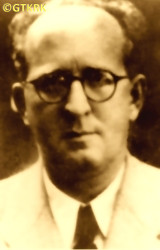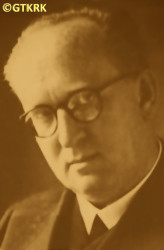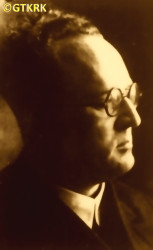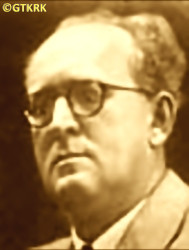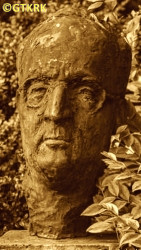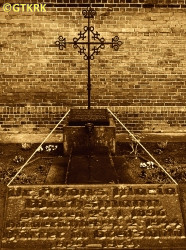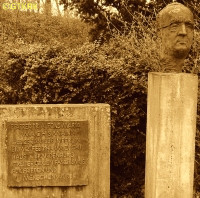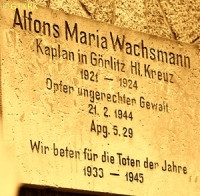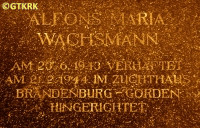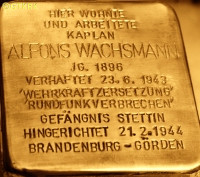Roman Catholic
St Sigismund parish
05-507 Słomczyn
85 Wiślana Str.
Konstancin deanery
Warsaw archdiocese, Poland
full list:
displayClick to display full list

searchClick to search full list by categories
wyświetlKliknij by wyświetlić pełną listę po polsku

szukajKliknij by przeszukać listę wg kategorii po polsku

Martyrology of the clergy — Poland
XX century (1914 – 1989)
personal data
religious status
Servant of God
surname
WACHSMANN
forename(s)
Alphonse Mary (pl. Alfons Maria)
function
diocesan priest
creed
Latin (Roman Catholic) Church RCmore on
en.wikipedia.org
[access: 2014.09.21]
diocese / province
Berlin diocesemore on
en.wikipedia.org
[access: 2013.12.04]
Wrocław diocesemore on
en.wikipedia.org
[access: 2013.05.19]
academic distinctions
Doctor of Philosophy
nationality
German
date and place
of death
21.02.1944

Brandenburg an der Haveltoday: Brandenburg an der Havel urban dist., Brandenburg state, Germany
more on
en.wikipedia.org
[access: 2022.06.29]
details of death
During World War I soldier of the German army (1914‐1919).
After German and Russian invasion of Poland in 09.1939 and start of the World War II arrested on 21.06.1943 in St Otto Caritas Center in Zinnowitz on Usedom island by the Germans, during „Fall Stettin” — action aimed at Catholic clergy — together with Fr Albert Hirsch, Fr Charles Lampert, Fr Frederick Lorenz, Fr Herbert Simoleit (all arrested earlier), among others.
Transferred to German political police Gestapo prison in Szczecin.
Interrogated numerous times and prob. tortured.
Accused of treason and sedition tried on 03.12.1943 by Volksgerichtshof, People's Court, German kangaroo court in Szczecin.
Sentenced to death.
On 05.01.1944 moved to prison — an Euthanasia Center used by Germans during genocidal «Aktion T4» plan — in Brandenburg an der Havel and there murdered — beheaded on guillotine.
cause of death
murder
perpetrators
Germans
sites and events
Fall StettinClick to display the description, «Aktion T4»Click to display the description, Ribbentrop‐MolotovClick to display the description, Pius XI's encyclicalsClick to display the description
date and place
of birth
25.01.1896

Berlintoday: Berlin state, Germany
more on
en.wikipedia.org
[access: 2020.07.31]
presbyter (holy orders)
ordination
06.1921

Wrocławtoday: Wrocław city pov., Lower Silesia voiv., Poland
more on
en.wikipedia.org
[access: 2021.04.02]
positions held
1929 – 1943
parish priest — Greifswaldtoday: Vorpommern‐Greifswald dist., Mecklenburg‐Vorpommern state, Germany
more on
en.wikipedia.org
[access: 2022.02.15] ⋄ St Joseph RC parish ⋄ Stralsundtoday: Vorpommern‐Rügen dist., Mecklenburg‐Vorpommern state, Germany
more on
en.wikipedia.org
[access: 2022.02.08] RC deanery
till 1935
PhD student — Greifswaldtoday: Vorpommern‐Greifswald dist., Mecklenburg‐Vorpommern state, Germany
more on
en.wikipedia.org
[access: 2022.02.15] ⋄ philosophy, Alma Mater Gryphiswaldensis (Eng. University of Greifswald)
1924 – 1929
vicar — Berlin‐Prenzlauer Berglocality in Berlin, Pankow borough
today: Berlin state, Germany
more on
en.wikipedia.org
[access: 2022.01.07] ⋄ Sacred Heart of Jesus RC parish ⋄ Berlintoday: Berlin state, Germany
more on
en.wikipedia.org
[access: 2020.07.31] RC deanery
till 1924
vicar — Görlitztoday: Görlitz dist., Saxony state, Germany
more on
en.wikipedia.org
[access: 2022.02.15] ⋄ Holy Cross RC parish ⋄ Lubańtoday: Lubań urban gm., Lubań pov., Lower Silesia voiv., Poland
more on
en.wikipedia.org
[access: 2021.04.02] RC deanery
1915 – 1921
student — Wrocławtoday: Wrocław city pov., Lower Silesia voiv., Poland
more on
en.wikipedia.org
[access: 2021.04.02] ⋄ philosophy and theology, Theological Seminary
others related
in death
HIRSCHClick to display biography Albert, LAMPERTClick to display biography Charles, LORENZClick to display biography Frederick, SIMOLEITClick to display biography Herbert
sites and events
descriptions
Fall Stettin: German action against Catholic church in Szczecin and Pomerania region. Using provocation — among others German political police Gestapo disseminated rumours that Catholic priest allegedly installed broadcasting radio‐station on top the St John the Baptist church steeple and were secretly transmitting information to London — on 04‐05.02.1943 Germans arrested 40 people, including 11 Catholic priests, friars and nuns, accusing them of spying for allies. Some of the arrested were subsequently murdered (including five Catholic priests ‐ four of whom were tried, sentenced to death and beheaded in the prison), the rest were sent to concentration camps. (more on: pl.wikipedia.orgClick to attempt to display webpage
[access: 2013.05.19])
«Aktion T4»: German state euthanasia program, systematic murder of people mentally retarded, chronically, mentally and neurologically ill — „elimination of live not worth living” (Germ. „Vernichtung von lebensunwertem Leben”). At a peak, in 1940‐1941, c. 70,000 people were murdered, including patients of psychiatric hospitals in German occupied Poland — German formalists noted then that, among others, „performing disinfection [i.e. gassing] of 70,273 people with a life expectancy of up to 10 years saved food in the amount of 141,775,573.80 Deutschmark”. From 04.1941 also mentally ill and „disabled” (i.e. unable to work) prisoners held in German concentration camps were included in the program — denoted then as «Aktion 14 f 13». C. 20,000 inmates were then murdered, including Polish Catholic priests held in KL Dachau concentration camp, who were murdered in Hartheim gas chambers. The other „regional extension” of «Aktion T4» was «Aktion Brandt» program during which Germans murdered chronically ill patients in order to make space for wounded soldiers. It is estimated that at least 30,000 were murdered in this program. (more on: en.wikipedia.orgClick to attempt to display webpage
[access: 2014.10.31])
Ribbentrop‐Molotov: Genocidal Russian‐German alliance pact between Russian leader Joseph Stalin and German leader Adolf Hitler signed on 23.08.1939 in Moscow by respective foreign ministers, Mr. Vyacheslav Molotov for Russia and Joachim von Ribbentrop for Germany. The pact sanctioned and was the direct cause of joint Russian and German invasion of Poland and the outbreak of the World War II in 09.1939. In a political sense, the pact was an attempt to restore the status quo ante before 1914, with one exception, namely the „commercial” exchange of the so‐called „Kingdom of Poland”, which in 1914 was part of the Russian Empire, fore Eastern Galicia (today's western Ukraine), in 1914 belonging to the Austro‐Hungarian Empire. Galicia, including Lviv, was to be taken over by the Russians, the „Kingdom of Poland” — under the name of the General Governorate — Germany. The resultant „war was one of the greatest calamities and dramas of humanity in history, for two atheistic and anti‐Christian ideologies — national and international socialism — rejected God and His fifth Decalogue commandment: Thou shall not kill!” (Abp Stanislav Gądecki, 01.09.2019). The decisions taken — backed up by the betrayal of the formal allies of Poland, France and Germany, which on 12.09.1939, at a joint conference in Abbeville, decided not to provide aid to attacked Poland and not to take military action against Germany (a clear breach of treaty obligations with Poland) — were on 28.09.1939 slightly altered and made more precise when a treaty on „German‐Russian boundaries and friendship” was agreed by the same murderous signatories. One of its findings was establishment of spheres of influence in Central and Eastern Europe and in consequence IV partition of Poland. In one of its secret annexes agreed, that: „the Signatories will not tolerate on its respective territories any Polish propaganda that affects the territory of the other Side. On their respective territories they will suppress all such propaganda and inform each other of the measures taken to accomplish it”. The agreements resulted in a series of meeting between two genocidal organization representing both sides — German Gestapo and Russian NKVD when coordination of efforts to exterminate Polish intelligentsia and Polish leading classes (in Germany called «Intelligenzaktion», in Russia took the form of Katyń massacres) where discussed. Resulted in deaths of hundreds of thousands of Polish intelligentsia, including thousands of priests presented here, and tens of millions of ordinary people,. The results of this Russian‐German pact lasted till 1989 and are still in evidence even today. (more on: en.wikipedia.orgClick to attempt to display webpage
[access: 2015.09.30])
Pius XI's encyclicals: Facing the creation of two totalitarian systems in Europe, which seemed to compete with each other, though there were more similarities than contradictions between them, Pope Pius XI issued in 03.1937 (within 5 days) two encyclicals. In the „Mit brennender Sorge” (Eng. „With Burning Concern”) published on 14.03.1938, condemned the national socialism prevailing in Germany. The Pope wrote: „Whoever, following the old Germanic‐pre‐Christian beliefs, puts various impersonal fate in the place of a personal God, denies the wisdom of God and Providence […], whoever exalts earthly values: race or nation, or state, or state system, representatives of state power or other fundamental values of human society, […] and makes them the highest standard of all values, including religious ones, and idolizes them, this one […] is far from true faith in God and from a worldview corresponding to such faith”. On 19.03.1937, published „Divini Redemptoris” (Eng. „Divine Redeemer”), in which criticized Russian communism, dialectical materialism and the class struggle theory. The Pope wrote: „Communism deprives man of freedom, and therefore the spiritual basis of all life norms. It deprives the human person of all his dignity and any moral support with which he could resist the onslaught of blind passions […] This is the new gospel that Bolshevik and godless communism preaches as a message of salvation and redemption of humanity”… Pius XI demanded that the established human law be subjected to the natural law of God , recommended the implementation of the ideal of a Christian state and society, and called on Catholics to resist. Two years later, National Socialist Germany and Communist Russia came together and started World War II. (more on: www.vatican.vaClick to attempt to display webpage
[access: 2023.05.28], www.vatican.vaClick to attempt to display webpage
[access: 2023.05.28])
sources
personal:
de.wikipedia.orgClick to attempt to display webpage
[access: 2019.04.16], www.gdw-berlin.deClick to attempt to display webpage
[access: 2019.04.16], newsaints.faithweb.comClick to attempt to display webpage
[access: 2025.04.13]
original images:
www.gdw-berlin.deClick to attempt to display webpage
[access: 2019.04.16], www.wiko-greifswald.deClick to attempt to display webpage
[access: 2019.04.16], kath-kirche-greifswald.deClick to attempt to display webpage
[access: 2019.04.16], redsearch.orgClick to attempt to display webpage
[access: 2019.04.16], vanderkrogt.netClick to attempt to display webpage
[access: 2019.04.16], commons.wikimedia.orgClick to attempt to display webpage
[access: 2021.12.19], commons.wikimedia.orgClick to attempt to display webpage
[access: 2021.12.19], www.tag-des-herrn.deClick to attempt to display webpage
[access: 2019.04.16], commons.wikimedia.orgClick to attempt to display webpage
[access: 2019.04.16], www.bistum-goerlitz.deClick to attempt to display webpage
[access: 2019.04.16], commons.wikimedia.orgClick to attempt to display webpage
[access: 2019.04.16]
LETTER to CUSTODIAN/ADMINISTRATOR
If you have an Email client on your communicator/computer — such as Mozilla Thunderbird, Windows Mail or Microsoft Outlook, described at WikipediaPatrz:
en.wikipedia.org, among others — try the link below, please:
LETTER to CUSTODIAN/ADMINISTRATORClick and try to call your own Email client
If however you do not run such a client or the above link is not active please send an email to the Custodian/Administrator using your account — in your customary email/correspondence engine — at the following address:

giving the following as the subject:
MARTYROLOGY: WACHSMANN Alphonse Mary
To return to the biography press below:
 Click to return to biography
Click to return to biography








